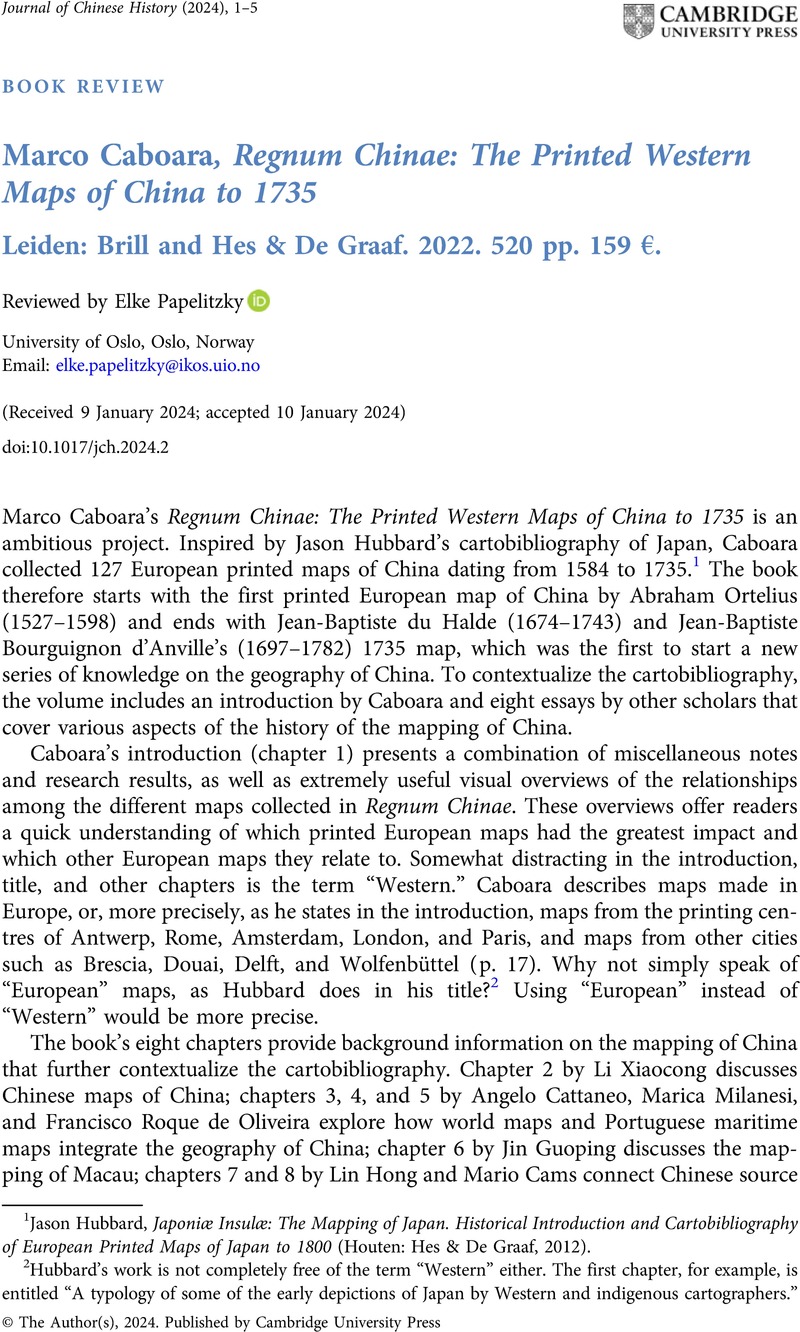No CrossRef data available.
Published online by Cambridge University Press: 01 February 2024

1 Hubbard, Jason, Japoniæ Insulæ: The Mapping of Japan. Historical Introduction and Cartobibliography of European Printed Maps of Japan to 1800 (Houten: Hes & De Graaf, 2012)Google Scholar.
2 Hubbard's work is not completely free of the term “Western” either. The first chapter, for example, is entitled “A typology of some of the early depictions of Japan by Western and indigenous cartographers.”
3 See for example the map in Xinban zengbu tianxia bianyong wenlin miaojin Wanbao quanshu 新板增補天下便用文林妙錦萬寶全書, 1612, in Harvard University Library, https://nrs.harvard.edu/urn-3:FHCL:2093485, j. 2, 2b–3a. For a list of other encyclopaedias that include such maps and a brief description, see Zhu Jianqiu 朱鑒秋 et al., eds., Zhongwai jiaotong guditu ji 中外交通古地圖集 (Shanghai: Zhongxi shuju, 2017), 171–73. Such maps are also found in comprehensive geographies, see Cams, Mario, “The Confusions of Space: Reading Ming China's Comprehensive Geographies,” Monumenta Serica 69 (2021): 530–31CrossRefGoogle Scholar.
4 Li assumes that an undated, untitled, and unsigned manuscript map reproduced by Walter Fuchs in 1937 is Huang Zongxi's 1673 map. However, this map contains place names that indicate it was made after 1678. To what degree this corresponds to Huang Zongxi's map is unknown. See Zhou Xin 周鑫, “Wang Ri'ang Da Qing yitong tianxia quantu yu 17–18 shiji Zhongguo Nanhai zhishi de shengcheng chuandi” 汪日昂《大清一统天下全图》与 17–18 世纪中国南海知识的生成传递, Haiyang shi yanjiu 海洋史研究 14 (2020): 231; Unno Kazutaka 海野一隆, Chizu bunkashijō no Kōyozu 地図文化史上の廣輿圖 (Tokyo: Tōyō bunko, 2010), 238.
5 Zhou Xin, “Wang Ri'ang Da Qing yitong tianxia quantu.” This map is held by the Kyujanggak Institute for Korean Studies at Seoul National University. Zhou Xin's article was published in January 2020, and according to Caboara's introduction (p. 27), he approached the contributors only in November 2020. This omission therefore is not due to a drawn-out publishing process.
6 Scholars who have noted the wrong date include Funakoshi Akio, Timothy Brook, Mario Cams, and Gong Yingyan: Akio, Funakoshi, “Some New Lights on the History of Chinese Cartography,” Annual Report of Studies in Humanities and Social Sciences of the Faculty of Letters Nara Women's University 19 (1975): 153–54Google Scholar; Brook, Timothy, Completing the Map of the World: Cartographic Interaction between China and Europe (Taipei: Zhongyang yanjiuyuan jindaishi yanjiusuo, 2020), 42–43Google Scholar, 166–67; Cams, Mario, “Circling the Square: Encompassing Global Geography on Large Commercial Maps,” in Remapping the World in East Asia: Toward a Global History of the “Ricci Maps,” ed. Cams, Mario and Papelitzky, Elke (Honolulu: University of Hawai'i Press, 2024), 137CrossRefGoogle Scholar. Lin Hong cites Gong Yingyan 龚缨晏, “Kunyu wanguo quantu yu ‘Zheng He faxian Meizhou’: Bo Li Zhaoliang de xiangguan guandian jinlun lishi yanjiu de kexue xing” 《坤舆万国全图》与“郑和发现美洲”—驳李兆良的相关观点兼论历史研究的科学性, Lishi yanjiu 历史研究, no. 5 (2019), 146–165, 192.
7 The confusion with dates continues: in Regnum Chinae, the date is given as “fifteenth year of the Jiajing period (1534)” (p. 48). However, Jiajing 15 is 1536. To be precise, the map gives the date as Jiajing bingshen 丙申, which is indeed the fifteenth year of Jiajing, i.e. 1536.
8 Miya Noriko 宮紀子, Mongoru teikoku ga unda sekaizu: Chizu ha kataru モンゴル帝国が生んだ世界図. 地図は語る (Tokyo: Nihon keizai shinbun shuppansha, 2007), 26. Unno Kazutaka also found other books printed in the seventeenth century by a publisher named Rinsendō located in Kyoto. Unno Kazutaka 海野一隆, “Edo jidai kankō no Ajia shoiki chizu” 江戸時代刊行のアジア諸域地図, in Tōyō chirigaku shi no kenkyū: Nihon hen 東洋地理学史の研究: 日本編 (Osaka: Seibundō, 2005), 358. I have followed Unno's and Miya's suggestion: Papelitzky, Elke, “Sand, Water, and Stars: Chinese Mapping of the Gobi and Taklamakan Deserts,” T'oung Pao 107, no. 3–4 (2021): 387CrossRefGoogle Scholar.
9 This statement also ignores that the 1461 Da Ming yitong zhi includes a map of the whole Ming state, which is mentioned by Li (pp. 40–41).